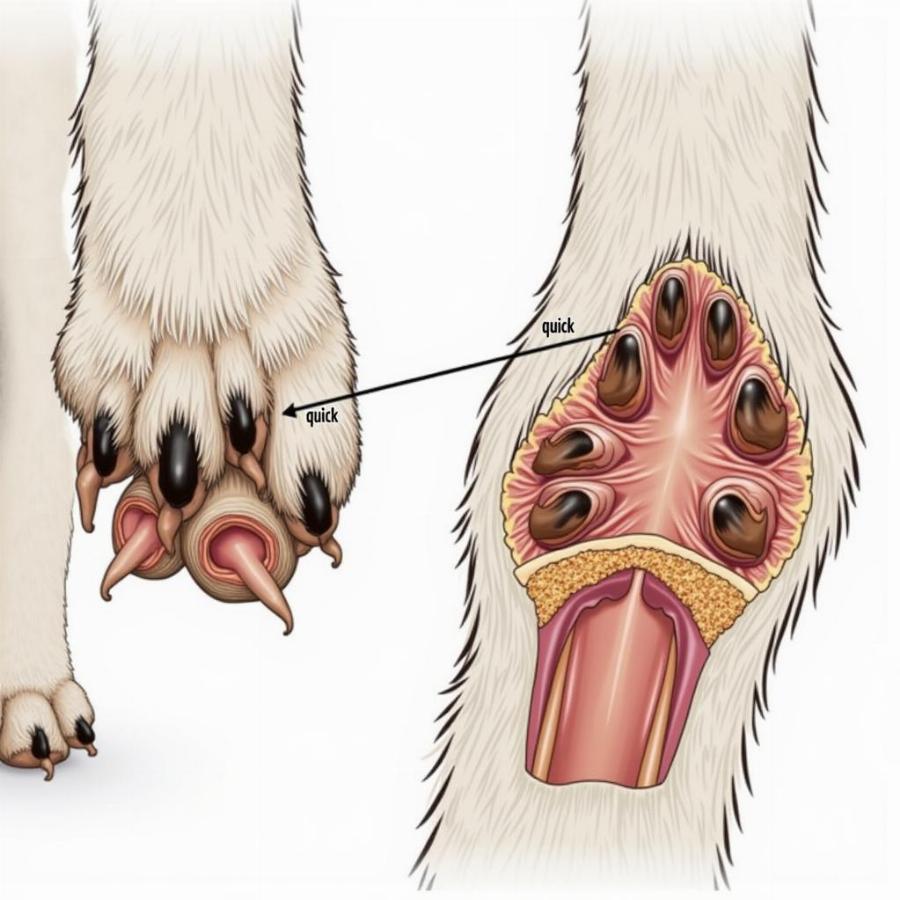Dog nail bleeding after trim is a common issue that many pet owners face. It can be a scary experience for both you and your furry friend, but understanding why it happens and knowing how to stop the bleeding quickly can make the whole process much less stressful. This comprehensive guide will cover everything you need to know about dealing with dog nail bleeding after a trim, from prevention to treatment.
Understanding Dog Nail Anatomy and Why Bleeding Occurs
 Cấu tạo móng chó và nguyên nhân chảy máu sau khi cắt tỉa
Cấu tạo móng chó và nguyên nhân chảy máu sau khi cắt tỉa
Inside your dog’s nail is a sensitive pink area called the quick, which contains nerves and blood vessels. Cutting into the quick causes pain and bleeding. Overgrown nails make it harder to avoid the quick, increasing the risk of bleeding. Dark-colored nails make the quick even harder to see, making trimming a challenge. Other factors that can contribute to bleeding include using dull clippers, applying uneven pressure, or a sudden movement from your dog.
How to Stop Dog Nail Bleeding
If you accidentally cut into the quick and your dog’s nail starts bleeding, don’t panic. Here’s a step-by-step guide to stop the bleeding:
- Apply pressure: Hold a clean cloth or gauze firmly against the bleeding nail for several minutes. This helps to slow down the blood flow and encourage clotting.
- Use styptic powder: Styptic powder is a readily available product specifically designed to stop bleeding nails. Gently dip the bleeding nail into the powder and maintain pressure for a few more minutes.
- Use cornstarch or flour: If you don’t have styptic powder on hand, cornstarch or flour can be used as an alternative. Pack a small amount onto the bleeding nail and apply pressure.
- Monitor the bleeding: Continue to monitor the nail for several minutes after the bleeding has stopped to ensure it doesn’t start again.
If the bleeding is profuse or doesn’t stop after 15-20 minutes, contact your veterinarian immediately.
Preventing Dog Nail Bleeding: Tips and Tricks
Prevention is always better than cure. Here are some tips to minimize the risk of dog nail bleeding:
- Use sharp clippers: Dull clippers crush the nail, increasing the risk of splitting and bleeding. Invest in a good quality dog trimming clippers.
- Trim nails regularly: Regular trims prevent the quick from growing too long, making it easier to avoid cutting into it.
- Take it slow: If your dog is anxious, trim only a few nails at a time. Positive reinforcement with treats can help create a more positive experience.
- Get professional help: If you’re unsure about trimming your dog’s nails yourself, consider taking them to a groomer or veterinarian.
What if My Dog Has a Broken Nail?
Sometimes, a dog’s nail can break without being trimmed. This can also lead to bleeding. The steps to stop the bleeding are the same as for a trimmed nail. However, if the break is severe, it’s important to stop dog bleeding and consult your veterinarian for further treatment. They might need to remove the broken nail completely and apply a bandage.
How to Identify the Quick in Dark Nails
Identifying the quick in dark nails is tricky. One technique is to shine a bright light through the nail. The quick will appear as a darker, triangular shape. You can also look at the underside of the nail. The quick will be visible as a pink triangle. If you’re still unsure, it’s always best to err on the side of caution and trim less rather than more. You may also find the dog middle finger to be a useful guide in some breeds.
When to Seek Veterinary Care
While most cases of dog nail bleeding after trim can be managed at home, there are instances where veterinary care is necessary:
- Profuse bleeding that doesn’t stop after 20 minutes of applying pressure.
- Signs of infection, such as swelling, redness, pus, or a foul odor.
- If you suspect the nail is broken or fractured.
Conclusion
Dog nail bleeding after trim is a common occurrence that can be easily managed with the right knowledge and tools. Understanding your dog’s nail anatomy, using proper trimming techniques, and knowing how to stop bleeding effectively can help make nail trims less stressful for both you and your furry friend. Remember, if you’re ever unsure, consult a professional. Don’t hesitate to contact your veterinarian or a groomer if you have any concerns about your dog trimming kit or technique.
FAQ
- What is the best way to stop dog nail bleeding? Apply pressure and use styptic powder, cornstarch, or flour.
- How can I avoid cutting the quick? Use sharp clippers, trim nails regularly, and take it slow.
- When should I call the vet? If the bleeding is profuse, doesn’t stop, or there are signs of infection.
- What should I do if I cut my dog’s nail too short? Follow the same steps to stop the bleeding and monitor for infection. See our article on cut dog toenail too short for more information.
Beaut Dogs is your one-stop resource for all things dog-related, offering expert advice and a wealth of information on dog breeds, care, and training. When you need assistance, email us at [email protected] (Email address) to get detailed and accurate answers from Beaut Dogs. Visit https://beautdogs.com to explore the wonderful world of dogs and learn how to care for them best.